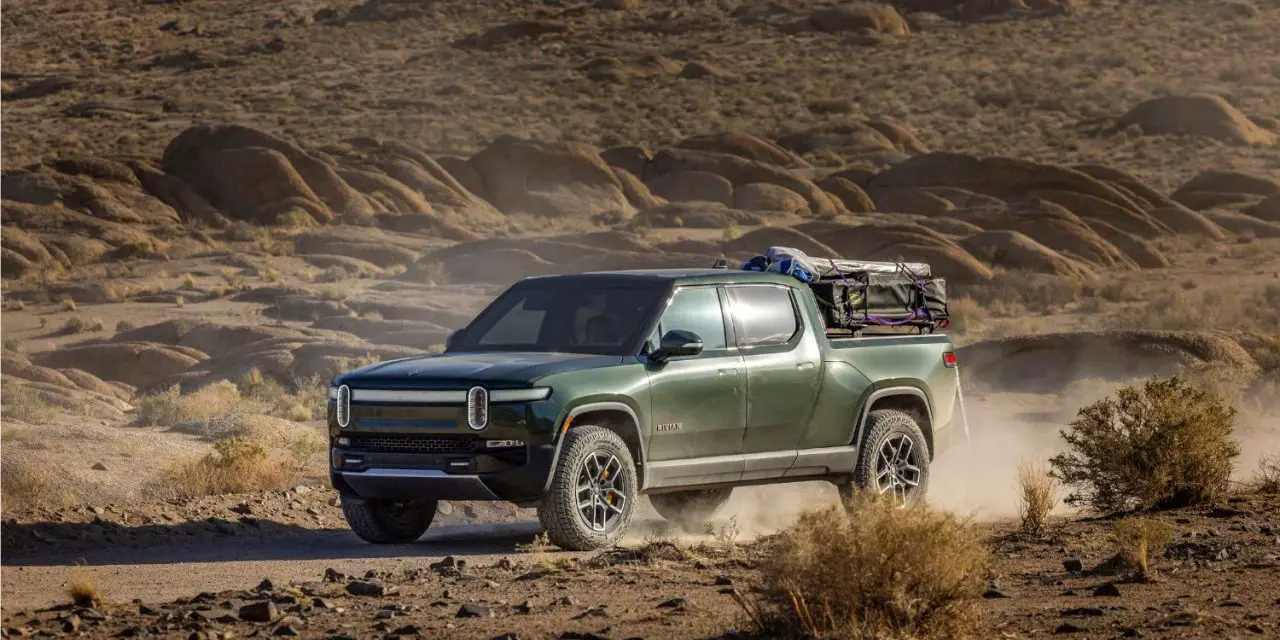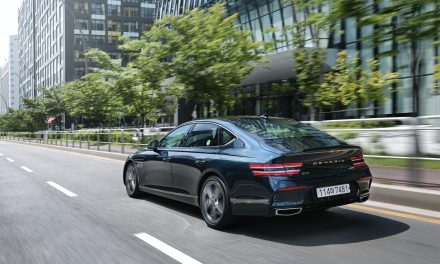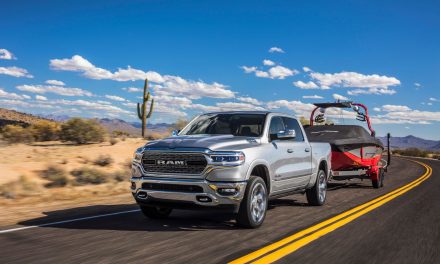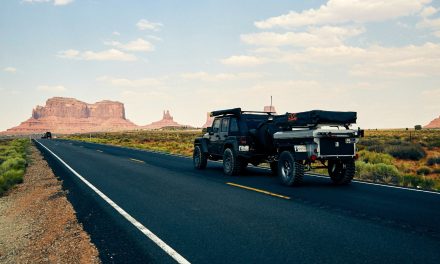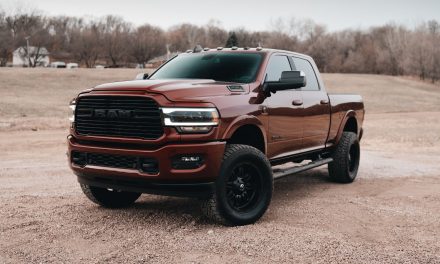There are two major things (among others) that has grown in popularity over the past couple of years. That would be Overlanding, which is essentially mixing camping, off-roading, and road tripping into one. The other is electric vehicles! However, do both of these mix together well, and which vehicles are the best ones to choose if you do want to mix the two.
The four major electric vehicles on that would make great Overlanding rigs would be the Ford F-150 Lightning, the Rivian R1T, Rivian R1S and of course the new GMC Hummer. Each of these work well as Overlanding vehicles in different ways, weather it be range, aftermarket support, or just pure size.
In this article, we will be going over each of these vehicles, what makes them stand out as the best, and help you decide which one is right for your purposes.
1. Ford F-150 Lightning (Our Choice)
| Ground Clearance | 8.4″ |
| Gross Vehicle Weight Rating (GVWR) | 8,250 pounds |
| MSRP | $46,974 |
| Gas Mileage | 320 miles |
You might be surprised to find the Lightning at the top of the list of best electric vehicles for Overlanding, however, hear me out. While the other vehicles like the R1T and R1S both are physically better for Overlanding, both of those are still early on in their production cycle. Meanwhile, the F-150 Lightning is essentially an F-150 with an electric drivetrain.
What does this mean? Every piece of Overlanding equipment that has been built for the current generation of F-150 will fit just fine on the Lightning. This opens doors for so much gear, for a much lower price than you can find for the other electric vehicles on this list.
Not to mention you have the backing of Ford, one of the oldest legacy automakers on this list. So as this new technology grows, you have the warranty of a company you can count on being around for the duration of your ownership.
The Ford F-150 Lightning also has exceptional range, as long as you are not towing, and it is equipped with the extended range battery. It is also able to assist you in running your campsite, as it is equipped with household style plugs throughout the vehicle.
2. Rivian R1T
| Ground Clearance | 14.4″ |
| Gross Vehicle Weight Rating (GVWR) | 8,532 |
| MSRP | $67,500 |
| Gas Mileage | 314 miles |
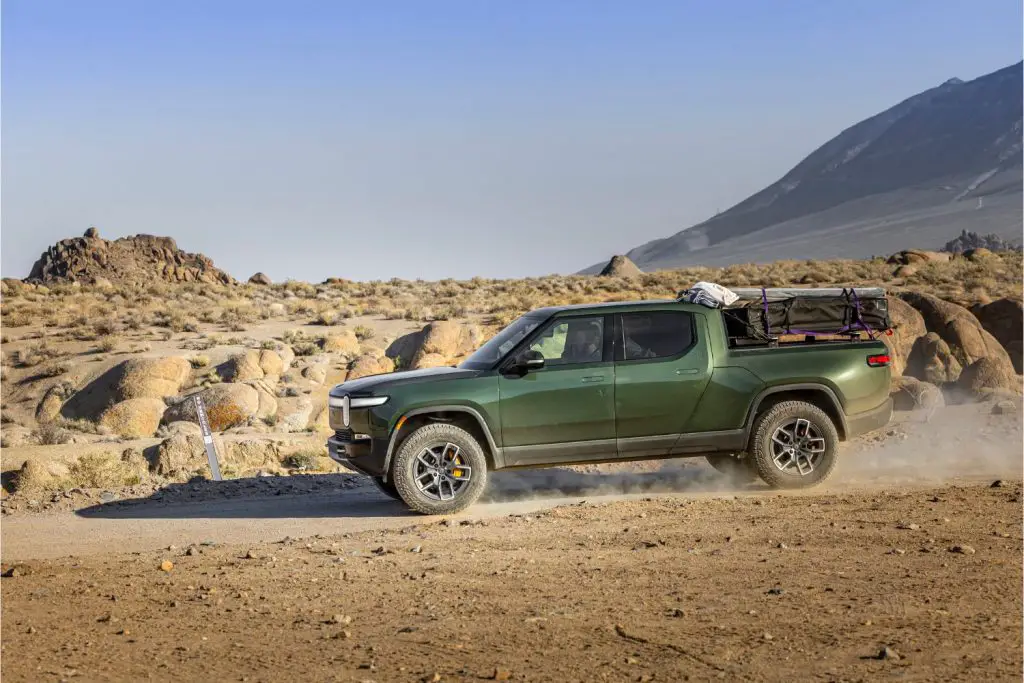
The Rivian R1T quickly is showing its success, as we start to see this vehicle on the road more and more. However, what most people aren’t aware of, is its off-road capabilities. Sure, it can go 0 to 60 in just 3 seconds, and sure it is a luxury vehicle. However it also has a gear tunnel behind the back doors where you can store items like it is a trunk, or you can always opt for purchasing the built in stove kit, which is perfect for your next cross-country adventure.
Build on these cool features with a massive 14.4″ ground clearance, an extremely usable bed, a front trunk (frunk), a mid-size build, 4 off-road modes, and even a possible “tank-turn” mode later one, and you have a recipe for a great Overland vehicle.
The R1T does have an impressive 314 miles of range, and a hefty GVWR of 8,532 pounds, which means it can carry a lot, while still getting quite a ways on one charge at a time.
3. Rivian R1S
| Ground Clearance | 14.9″ |
| Gross Vehicle Weight Rating (GVWR) | 7,650 |
| MSRP | $72,500 |
| Range | 316 miles |
Did you like the Rivian R1T pickup above, but wish it was available as an SUV? Well, that is where the R1S comes into play. It has all of the awesome feature of the pickup, however it is 200.8″ long, instead of 217.1″ of the pickup (making it even more ideal for off-roading), and it does away with the bed, and replaces it with a cabin instead.
The R1S comes standard with crossbars, which makes it easy to install a roof top tend, or any other gear on the roof of the vehicle you could want. This frees up the interior of the vehicle for passengers!
This vehicle is truly a great all-around vehicle, and that includes being an awesome Overlanding rig, if you are looking for a good electric option.
4. GMC Hummer EV
| Ground Clearance | 15.9″ |
| Gross Vehicle Weight Rating (GVWR) | 10,550 |
| MSRP | $108,700 |
| Gas Mileage | 329 miles |
Now, not everyone has over $100,000 laying around for the new GMC Hummer EV. However, for those that do, this vehicle could make a decent Overlanding rig. I have this one at the bottom of the list though, partially due to the price, but also partially because the bed of this truck is not quite as usable as other options on this list. The bed of the truck is important to Overlanding, and with its sloping rear end, it doesn’t allow for tents or other Overlanding gear to be included on the vehicle.
If you can get past that main downside, it does have plenty of upsides! This includes an incredible ground clearance of 15.9″ (which is the highest one on this list, and many other lists out there), a crab walk feature that lets it move diagonally, and tons of cameras (including one underneath the vehicle). If you want true luxury, and an electric vehicle that has serious off-road credentials, then the Hummer EV might be for you.
What is Overlanding?
Now that we have talked about what electric vehicles are great for Overlanding, let’s get a better understanding of what Overlanding really is.
Overlanding is a type of long-distance, off-road travel that takes place in both remote and urban areas. Similar to backpacking or camping, Overlanders typically bring all of their supplies with them in a vehicle or on foot. However, Overlanding often involves more advanced planning and preparation, as well as a higher level of self-reliance.
Overlanders typically travel in small groups or alone, and they often stay in remote areas for extended periods of time. While some Overlanders embark on their journeys for the sake of adventure, others use Overlanding as a way to connect with nature or to learn new skills. No matter what the motive, Overlanding can be an incredibly rewarding experience.
7 Things You Need to Pay Attention to When Overlanding in an Electric Vehicle
1. Gross Vehicle Weight Rating (GVWR)
When outfitting a vehicle for Overlanding, one of the most important considerations is the gross vehicle weight rating (GVWR). This number indicates the maximum weight that a vehicle can safely carry, and it includes the weight of the vehicle itself, any passengers, cargo, and fuel.
As such, it’s important to pay attention to the GVWR when adding any aftermarket equipment to a vehicle, as even seemingly lightweight items can add up quickly and put the vehicle over its maximum capacity.
In addition, exceeding the GVWR can void the manufacturer’s warranty and cause damage to the vehicle’s suspension and brakes. As such, it’s always best err on the side of caution when packing for an Overlanding trip and make sure that everything stays within the GVWR.
2. Approach Angle
When driving off-road, one of the most important considerations is the approach angle of your vehicle. This is the angle between the ground and the lowest point on your car, and it determines how steep of an incline you can safely negotiate.
For electric vehicles, it’s even more important to pay attention to the approach angle, since the battery pack is often located underneath the car. This means that if you drive too steep of an incline, you run the risk of damaging the battery.
In general, electric vehicles have a lower approach angle than gasoline-powered cars, so it’s important to take this into account when planning your route. By paying attention to the approach angle, you can help ensure that your electric vehicle will be able to safely navigate even the most challenging off-road terrain.
3. Departure Angle
Departure angle is the measure of how steep a slope your vehicle can safely navigate without bottoming out in the rear of the vehicle.
This is important to consider because electric vehicles tend to have a lower ground clearance than their gasoline-powered counterparts. As a result, it’s important to pay close attention to the departure angle when planning your route.
4. Breakover Angle
The breakover angle is the angle at which the middle of the body of your vehicle will touch the ground if it’s traveling over an obstacle. If the breakover angle is too low, your vehicle can get hung up on the obstacle and possibly flip over.
That’s why it’s important to pay attention to the breakover angle when you’re planning your route. If you’re not sure what your vehicle’s breakover angle is, you can usually find it in the owner’s manual.
Alternatively, you can measure it yourself by checking the clearance between the ground and the bottom of your vehicle. Keep in mind that obstacles can vary in height, so it’s always best to err on the side of caution and choose a route with a high breakover angle.
5. Cargo capacity
Make sure to check your vehicle’s cargo capacity before setting out on your trip. That way, you’ll know how much stuff you can bring with you and whether or not you’ll need to make additional arrangements. Paying attention to cargo capacity is just one of the many things you need to keep in mind when Overlanding with an electric vehicle.
6. Electric Range
When you’re out on the open road, the last thing you want is to run out of juice. That’s why it’s important to pay attention to your electric range when Overlanding with an electric vehicle. Knowing how far you can go on a single charge will help you plan your route and make sure you don’t get stranded in the middle of anywhere.
There are a few things to keep in mind when estimating your range. First, consider the terrain. If you’re driving on flat highways, you’ll be able to go further than if you’re constantly climbing steep hills.
Second, think about how much weight you’re carrying. A fully loaded car will use more energy than an empty one. And finally, keep an eye on the weather. Hot temperatures will drain your battery faster than cold ones. By being mindful of these factors, you can ensure that you’ll always have enough charge to get where you’re going.
7. Comfort
One of the best things about Overlanding is that it allows you to get away from it all and enjoy some time in nature. But that doesn’t mean you have to sacrifice comfort. Many Overlanding vehicles are designed with comfort in mind.
When choosing an Overlanding vehicle, look for features like comfortable seats, plenty of legroom, and a spacious interior. These features will help make your trip more enjoyable and ensure that you’re comfortable even when you’re spending hours on the road.
Additionally, pay attention to the climate control system in your vehicle. Overlanding can take you to some pretty extreme locations, so it’s important to make sure that your vehicle can keep you comfortable no matter what the temperature is outside.
Conclusion
Overlanding is a great way to explore the outdoors and enjoy some time in nature. But it’s important to choose the right vehicle for the job. Keep the factors discussed in this article in mind when choosing an Overlanding vehicle, and you’ll be sure to find the perfect one for your needs. Thanks for reading!

